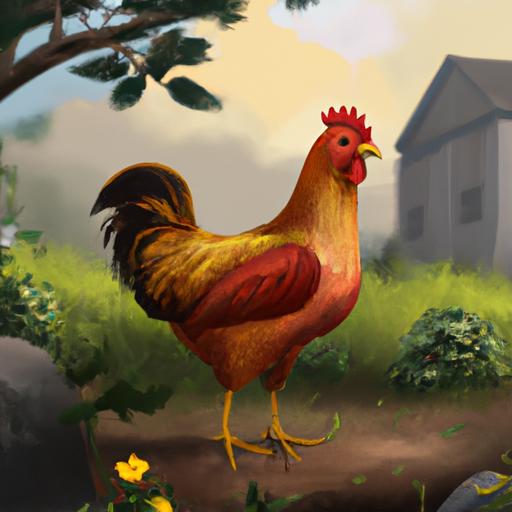Have you ever wondered what do you call a chicken without legs? It’s a curious question that has many surprising answers.
In this article, we will explore the reality of what a chicken without legs looks like, the different types of breeds and their related characteristics, how to care for a chicken without legs, the benefits of keeping such a poultry, the tools to make life easier for them, and finally, what do you call a chicken without legs? Dive in and find out the surprising answers to this curious question.
Table of Contents
Short Answer
No, you would not call a chicken with no legs as it is not alive and unable to move.
Chickens without legs can be created through genetic engineering or through an accident, but they are usually not able to survive.
If a chicken without legs is found, it is usually humanely euthanized.
What is a Chicken Without Legs?
A chicken without legs is still a chicken, despite its inability to walk.
Depending on the breed, chickens without legs can still lead a full and healthy life.
While the chicken may need assistance to move around, it can still enjoy an active and vibrant life.
While it may look strange to see a chicken without legs, it is still the same species and should be treated with the same respect as any other chicken.
Chickens without legs may require special care and attention.
They may need to be provided with a wheeled cart or other support to move around.
Additionally, it is important to provide them with a comfortable and safe place to rest.
The chicken should be given regular check-ups to ensure it is healthy and able to live a full life.
Overall, it is important to remember that a chicken without legs is still a chicken.
They may have a unique look, but they are still the same species and should be treated with the same respect and care as any other chicken.
With the right care, these chickens can still live a full and active life.
Different Types of Chicken Breeds

Chickens come in a variety of breeds, each of which can have different characteristics. Some breeds, such as the Rhode Island Red, are known for their sturdy legs and impressive flying ability, while other breeds, like the Silkie or Brahma, are known for their fluffy feathers and docile personalities. However, all chickens have one thing in common: they are capable of living a full and active life, even without legs.
The type of breed can have an effect on how chickens cope without legs.
For instance, some breeds, like the Silkie, have feathers that are so thick they can act as a cushion, helping the bird to move around more easily.
Other breeds, like the Brahma, are known for their docile nature, which can make them more content to stay in one place.
No matter the breed, if a chicken finds itself without legs, it can still live a full and active life with the right care and support.
Many breeders have developed wheeled carts to help chickens get around, and some chickens have even been known to learn how to move around in a different way, like using their wings.
Ultimately, with love and care, chickens can still lead a happy life without legs.
How to Care for a Chicken Without Legs
Caring for a chicken without legs is a bit different than caring for a chicken with legs, but its still possible to provide a comfortable and healthy life for your feathered friend.
The first step is to provide a safe environment with plenty of space.
Because the chicken cant walk, it will need to find other ways of getting around.
A wheeled cart is a great solution, as it will allow the chicken to travel freely.
Its also important to make sure the chickens environment is free of obstacles that could pose a danger.
In terms of nutrition, chickens without legs need the same diet as chickens with legs.
This means providing a balanced diet of grains, vegetables, and protein.
Its also important to make sure the chicken gets enough calcium to maintain healthy bones and a strong immune system.
Finally, chickens without legs need extra care and attention from their owners.
This means checking on the bird regularly to make sure its not in distress.
Its also important to provide mental stimulation to help keep the chicken entertained.
This could include providing toys and treats, as well as talking to the bird and giving it plenty of affection.
With these simple steps, you can ensure that your chicken without legs has a happy and healthy life.
Benefits of Keeping a Chicken Without Legs

For those looking to keep a chicken without legs, there are several benefits to consider.
For one, chickens without legs are typically much easier to care for, as they dont require the same level of exercise as a chicken with legs.
Chickens without legs will still be able to roam the yard and get fresh air, but they dont need to worry about running around and burning off energy.
This can be a huge relief for those who are pressed for time, or dont have the resources to provide adequate exercise for a chicken with legs.
Chickens without legs also have a much lower risk of injury or illness than a chicken with legs.
Without the need to move around as much, chickens with no legs are not as exposed to the risk of strains, sprains, and other potential injuries that come with an active lifestyle.
Furthermore, since they are not as active, chickens without legs are also less likely to be exposed to bacteria or viruses that can be found in the environment.
Finally, chickens without legs are often much calmer than their counterparts.
Without the need to move around constantly, chickens without legs can become used to being handled, making them much easier to care for.
This can be especially beneficial for those who are looking for more of a companion animal than a farm animal.
In the end, chickens without legs can be a great addition to the family.
By providing a safe and comfortable environment, chickens without legs can still live active and healthy lives.
With the right care, they can be a wonderful addition to any household.
Tools to Assist a Chicken Without Legs
For a chicken with no legs, there are a few tools and aids that can help them enjoy a full and active life.
One of the most common and widely used tools for chickens without legs is a wheeled cart.
This can help them move around and keep up with the other chickens.
The cart should be specifically designed for chickens, with adjustable heights and a base that will not tip over.
It should also come with accessories such as a ramp, food and water holders, and a perch for resting.
Other tools that can help a chicken without legs include ramps for getting in and out of the coop, and non-slip mats for the floor of the coop.
These mats can help the chicken get around more easily, as they provide sure footing.
Additionally, they can help prevent sores on the chicken’s chest from dragging.
Finally, regular and frequent physical exams are important for chickens with no legs.
These exams can help detect any potential health issues that may arise, such as infections or injuries.
Regular exams can also help ensure that the chickens remain healthy and active.
What Do You Call a Chicken Without Legs?

When it comes to chickens, having legs is an essential part of their anatomy. Without legs, chickens can’t move around or explore their environment. So, what do you call a chicken with no legs? The answer is simple: you call it a chicken.
Yes, a chicken with no legs is still a chicken, even if it can no longer walk.
Depending on the breed, chickens can still live a full life without legs.
Some chickens may need to be provided with wheeled carts or other support to get around, but they can still enjoy a healthy and active life.
For example, bantam chickens, which are a type of miniature chicken, are often unable to walk due to their size.
These chickens can often be seen scurrying around in wheeled carts, and they can live a full and happy life, even without their legs.
Other breeds of chickens may be born without legs, or may suffer from a condition called “bumblefoot,” which can cause chickens to lose the use of their legs.
In these cases, it’s important to provide the chickens with the necessary care and support to help them live a long and healthy life.
Ultimately, it’s important to remember that a chicken without legs is still a chicken, and they deserve the same love and care as any other chicken.
With the right support, chickens with no legs can still live a full and active life.
Surprising Answers to What Do You Call a Chicken Without Legs?
We all know that chickens need their legs to walk, but what do you call a chicken without legs? Surprisingly enough, the answer is still a chicken! Despite being unable to walk, chickens without legs can still live happy and healthy lives.
In fact, depending on the breed, they may be able to live a full life with the help of a wheeled cart or other support.
Chickens without legs may not be able to roam around freely like their counterparts, but they can still enjoy the same activities.
They can peck and scratch the ground, take dust baths, and even roost in the evening.
Chickens without legs are also able to get around with the help of a wheeled cart.
This cart allows them to get around and even keep up with their flockmates.
When it comes to caring for a chicken without legs, it’s important to make sure they get enough exercise.
This can be done in the form of supervised free-range time or even through special exercises.
It’s also important to provide them with a comfortable wheeled cart and to monitor their mobility.
Proper nutrition is also key to keeping chickens without legs healthy.
At the end of the day, it’s important to remember that a chicken without legs is still a chicken.
They may need some extra love and care, but they can still live a full and healthy life.
So, don’t be afraid to give a chicken without legs a chance, they just might surprise you!
Final Thoughts
At the end of the day, no matter what you call a chicken without legs, it’s still a chicken.
With the right care and tools, chickens without legs can live healthy and active lives.
If you’re considering keeping a chicken without legs, make sure to research the different types of breeds, as well as the best ways to care for them.
By doing this, you can help ensure your chicken will have a long, healthy, and happy life.

